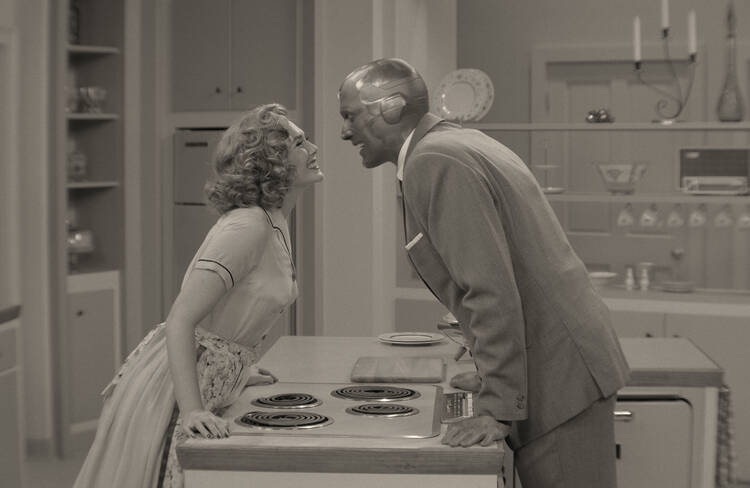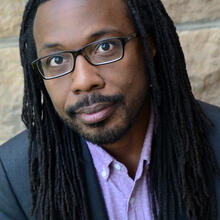Superheroes Wanda Maximoff and Vision, the protagonists of the hit show “WandaVision” on Disney+, don’t quite understand what’s happening around them, but they do know that they must hide their powers and learn to fit in. They are simply happy to be together. The boss and his wife are coming to dinner and Wanda must impress with her homemaking skills. Comedic shenanigans and mischief ensue.
And so it is with every episode of “WandaVision,” a new black and white, 4:3 aspect ratio offering from Marvel Cinematic Universe. Wanda (Elizabeth Olson) and Vision (Paul Bettany), a couple who once played only supporting roles in the “Avengers” films, are the stars of the show. Stranger still, with each episode, the show’s world advances a decade, drawing inspiration along the way from beloved American sitcoms like “I Love Lucy,” “Bewitched” and “The Brady Bunch.” But—even as their world changes—the people of Westview, N.J., stay the same.
Every new decade of WandaVision’s world leaves the audience with a sense of eeriness... the sole purpose of most of the supporting characters is to serve Wanda’s narrative,
Every new decade of WandaVision’s world leaves the audience with a sense of eeriness. It becomes increasingly clear that the sole purpose of most of the supporting characters is to serve Wanda’s narrative, and that something is bizarrely wrong, that the people of the town are all intricately tied to Wanda. These poignant “Twilight Zone” moments are intriguing and demand the audience to invest in the couple’s life, coaxing us into returning, reminding us to “Please Stand By,” episode after episode.
Mainstream television programming requires an appeal to common themes and tropes if it is to reach a broad and diverse audience. This nine-episode mini-series capitalizes on that broad appeal, while simultaneously pressing audiences to work harder as they enter a whole world of complex storytelling, cinematic style and gendered perspectives—all in mythic proportions.
Is Westview even a real place? Yes. But at the end of the third episode, we learn that Wanda, in a moment of uncircumventable grief—that even she doesn’t completely appear to understand—has refashioned the whole town into her version of a perfect home: the sleepy, safe and serene suburb of popular American television. And since we know that Vision died in “Avengers: Infinity War,” we also know that Wanda somehow managed to recreate him. But how?
Wanda is a woman filled with paradox. Her creations show the immense power of her imagination and are rooted in a desire to set the world right—even if it is in her own image. After a series of soul-crushing losses, she needed to recover goodness. The last moment she remembers of a grief-free existence was watching “The Dick Van Dyke Show” with her family just before their home was bombed. The warmth of Mary Tyler Moore’s smile became her standard of happiness.
“What is grief if not love persevering?” the original Vision suggests to Wanda in a memory.
“What is grief if not love persevering?” the original Vision suggests to Wanda in a memory, as he tries to console her following the death of her brother. And so, in her newly created world, that persevering love is personified (almost immortalized) by Vision himself. This conditional Vision, as he later refers to himself, embodies what is most true about their relationship and gives Wanda the strength to let go, even of him.
Eventually, it is this Vision that is fashioned from Wanda’s memory, who calls her to accept the truth. But only after a whole town of people is forced, involuntarily, to experience extreme mental anguish in pursuit of Wanda’s objective to create the life she never had. The townspeople’s lives are disrupted, sharing Wanda’s nightmares, experiencing in their sleep the very terrors that plague her. They are stuck in her creation, suppressed “flesh puppets,” as one character describes them. The warmth of their smiles and the innocence of their comedic antics hide a crippling truth from Wanda: that her attempt to escape trauma is traumatizing others.
“WandaVision,” with its sophisticated storytelling, using television genres as a literary device, pushes classic sitcom tropes in unexpected ways. Sitcoms represent Wanda’s desire for a home with a family who love her, a place where her identity can be rooted. The genre becomes a device for revealing the complexities of the central character’s psyche. But it becomes evermore apparent—with every new, simple problem solved in 30 minutes and every endearing moment of slapstick comedy—that Wanda is lost.
Wanda is a woman filled with paradox. Her creations show the immense power of her imagination and are rooted in a desire to set the world right—even if it is in her own image.
The series premiere begins in media res, teasing us with a few horror film-like clues. The boss’s wife looks directly into the camera repeatedly telling someone to “Stop it!” But to whom is her command directed: her husband, who is choking on a piece of food, or Wanda? The episode ends abruptly and on a mild cliffhanger. Wanda and Vision don’t understand what’s going on and neither do we. Though somewhat discombobulating, the technique works largely because Marvel producers have loyalty and goodwill from their audiences over the years. “WandaVision” thrives on provoking delayed gratification and a willingness from its audience to accept subtleties. Please Stand By.
“WandaVision” is thoroughly feminist. The series creator and showrunner is a woman, along with half the writing team. Most of the central characters are also women.
Though strong emotional responses to loss are universally human, one of feminism’s important projects is to recover emotion, not only as instinctual, and almost always subordinate to a dispassionate reason, but as vital to one’s self-understanding. Emotion is a primary way of knowing in “WandaVision.”
Captain Monica Rambeau attempts multiple times to reenter the “Hex,” the magical bubble in which Wanda can assert full control over reality, in order to try to reach her and help her come to grips with what she has done. Another female character—revealing her name would be an instant spoiler—drives Wanda to examine her past trauma. “The only way forward,” she tells Wanda, “is back.”
Though strong emotional responses to loss are universally human, one of feminism’s important projects is to recover emotion, not only as instinctual but as vital to one’s self-understanding.
Rambeau and the other woman understand that the most effective way to reach Wanda is to help her understand herself. Even Wanda’s antagonist becomes her therapist and interlocutor. “How did we get here, Wanda?” she asks. The women of this series are autonomous, complex characters whose choices matter. Women who employ reason and emotion. They know that emotions are key to understanding what we really think about ourselves and about others at the deepest levels and that there is no way around trauma, only through it. Vision, though not a woman, is the ideal partner and a perfect feminist ally. He doesn’t stand in the way of Wanda’s growth and is the most empathetic of all. He is thoughtful, trusting and unthreatened by Wanda’s lead. In the final battle, it is he who stays back to protect the children. The future of their world and home is left in Wanda’s hands.
And so ultimately, Wanda fashions a world of pathos not logos. Instead of logic and reason, usually associated with the Greek concept of logos, Wanda creates, from the bottomless pit of her grief and loss. She lost her parents at age 10, later her brother, and even after finding love and a life again with Vision, he too is taken away. Twice.
Whereas Tyler Hayward, the S.W.O.R.D. director who stands outside of Wanda’s Hex seeks to cope with the overwhelming knowledge that the Earth is under constant threat by building new weapons, Wanda is busy refashioning Westview into a place of apparent safety and peace. Her pathos, her life experience and her suffering give way to a curated domestic paradise where “shenanigans and mischief,” only lead to wholesome life-lessons. No one really gets hurt, as Wanda says, “It's not that kind of show.”
Powerful as Wanda is, her imagination is still stunted. She has yet to do the work of real hope
But as powerful as Wanda is, her imagination is still stunted. She has yet to do the work of real hope, which requires her to imagine a flourishing world beyond her perfect imagination—after trauma, not devoid of it. The only way forward is to face death squarely, embracing what might lie before her when she lets go of her previous expectations. And who she might be without Vision, present to her in the flesh.
We all need the essential faculty of the imagination. It allows us to make sense of the sometimes jagged, disparate shards of life after loss, imagining something altogether new. Because Wanda’s power is mythic, her story can help us sharpen our own tools for making sense of the senseless. She, like us, must embrace grief, sit in it, waiting in that liminal space between Good Friday and Easter Sunday. The mourning of Easter Saturday cannot be skipped. Perhaps Wanda Maximoff is like the deserted city of the book of Lamentations:
How lonely sits the city
that once was full of people!
How like a widow she has become,
she that was great among the nations!
Pour out your heart like water
before the presence of the Lord!
More from America:
- We’re all desperate for hope. Ted Lasso is here to deliver it.
- Netflix’s ‘Bridgerton’ is a feminist disaster. But it (almost) redeems itself.
- Golden Globe winner ‘Nomadland’ is a portrait of late-stage capitalism in America
- HBO’s ‘Judas and the Black Messiah’ is a Christ-like tale of betrayal — minus the redemption









